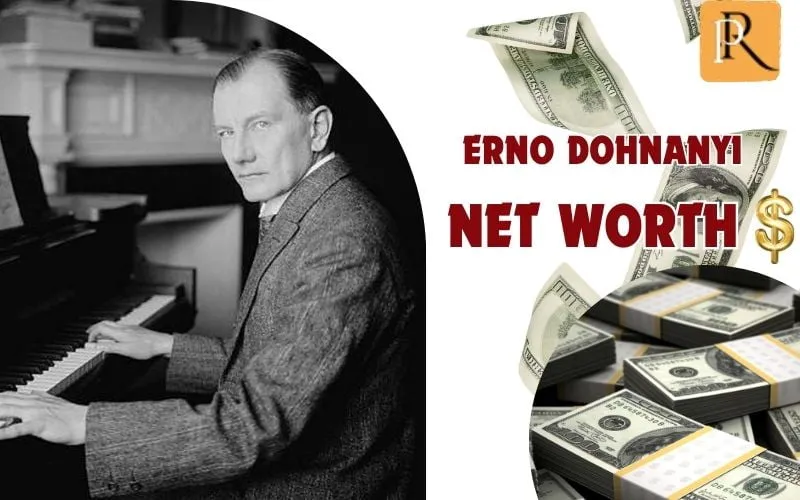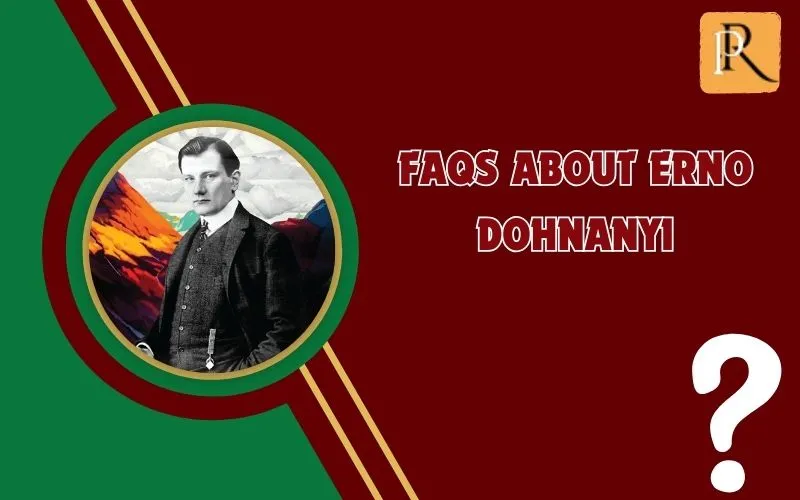Have you ever wondered about the financial aspects behind some of the best classical pianists? Today, we delve into the fascinating world of Ernő Dohnányi, a towering figure in classical music.
Rachel Parris will explore the income, investments and financial legacy that cemented his place among elite musicians. Read on to discover the secrets behind Erno Dohnanyi’s net worth and what makes him financially unique.
Quick information
| TRUTH | DETAIL |
|---|---|
| Real name | Ernő Dohnányi |
| Popular name | Ernst von Dohnányi |
| Sex | male |
| Date of birth | July 27, 1877 |
| Year old | Died February 9, 1960 (82 years old) |
| Parents | Frigyes Dohnányi and Ottilia Szlabey |
| Siblings | do not apply |
| Place of birth | Pozsony, Kingdom of Hungary (now Slovakia) |
| Nationality | Hungarian |
| Nation | Hungarian |
| Education | Royal Hungarian National Academy of Music |
| Marital status | Married |
| Sexual orientation | Straight |
| Wife/Wife/husband | Elisabeth Kunwald, Elsa Galafrés, Ilona Zachár (serial spouses) |
| Children | Hans von Dohnányi, Greta Dohnányi and their stepchildren |
| Dating | do not apply |
| Net value | Estimated $23 million (at time of death) |
| Origin of wealth | Composing, performing, and teaching music |
| Year of operation | 1895–1960 |
| Category | Classic, Romantic |
| Height | do not apply |
What is Ernő Dohnányi’s net worth in 2024?

As we delve into the world of classical music, composers’ finances are often as fascinating as their works. Ernő Dohnányi, an important figure of the 20th century, had amassed a net worth estimated at $23 million by the time of his death in 1960.
Comparatively, his contemporaries such as Béla Bartók, Annie Fischer and Zoltán Kodály had different financial trajectories due to different levels of commercial success and international recognition.
Although exact figures for Bartók and Kodály are not available, it is known that their legacy, like Dohnányi’s, continues to accumulate value through royalties and ongoing performances.
Annie Fischer, who is famous for her pianistic interpretations, also achieved considerable success, although her net worth is not published in as much detail as Dohnányi’s.
Ernő Dohnányi Full overview and Wiki

Early life and influence
Born in 1877 against the historical backdrop of Pozsony, Ernő Dohnányi’s life was set against the backdrop of a rapidly changing Europe. His father, a mathematics professor with a passion for the cello, and his early musical foundation under Carl Forstner, laid a solid foundation for what would become a musical career. monumental.
Early start
Dohnányi’s career began with formal music studies at the Royal Hungarian National Academy of Music, where he studied piano under István Thomán and composition under Hans von Koessler.
His early exposure to the rigorous standards of classical music, combined with his natural talent, set the stage for a promising musical career.
Breakthrough and outstanding
Dohnányi’s breakthrough came with his first published work, the Piano Quintet in C minor, which received the approval of Johannes Brahms. This endorsement not only solidified his reputation but also opened up opportunities to perform throughout Europe.
His debut in Berlin in 1897 received critical acclaim, establishing him as a highly accomplished artist.
Internationally acclaimed
His career continued to flourish with tours in Europe and the United States, where he was particularly noted for his performance of Beethoven’s Fourth Piano Concerto. Dohnányi’s ability to combine profound musical expression with technical precision has made him a favorite among classical music enthusiasts.
Contribution to chamber music and orchestral works
In addition to his solo performances, Dohnányi also has a deep interest in chamber music, which is reflected in his extensive performances and compositions in this genre. His Symphony No. 1 marked his foray into orchestral music, demonstrating his versatility and deep understanding of musical forms.
Academic and directorial roles
Dohnányi also devoted a significant part of his career to teaching and nurturing the next generation of musicians. He served at the Hochschule für Musik in Berlin and later played a key role at the Budapest Academy of Music. His influence as an educator extended to his students, many of whom became famous musicians.
Promotion of Hungarian composers
During his tenure as Music Director of the Budapest Symphony Orchestra, Dohnányi was instrumental in promoting Hungarian composers, including Béla Bartók and Zoltán Kodály. His efforts during these years helped elevate Hungarian music internationally.
Creation and inheritance
Dohnányi’s compositions, such as Variations on Nursery Rhymes and American Rhapsody, demonstrate a blend of complexity and accessibility that has earned him a prominent place in the annals of classical music.
His work not only reflected the rich tradition of Romantic music but also conveyed elements of Hungarian folk music, placing him in line with the nationalist trends of his time.
The years that followed and the legacy
After moving to the United States after World War II, Dohnányi continued to teach and compose. His last major works include American Rhapsody and his revision of the Second Symphony. His dedication to music remained unwavering until his last public performance in 1960, shortly before his death.
Personal life
Dohnányi’s first marriage was to Elisabeth Kunwald, also a pianist. This union produced a son, Hans von Dohnányi, born in 1902.
After his first marriage ended, Dohnányi married Elsa Galafrés, a German actress and singer. They met during a time when they were both married to other partners and their spouses initially refused to allow them to divorce.
Despite these challenges, Dohnányi and Galafrés had a son, Matthew, in 1917, before divorcing and officially marrying in 1919. Dohnányi also adopted Elsa’s son, Johannes, from a previous marriage. with Polish-Jewish violinist Bronisław Huberman.
Later, Dohnányi married Ilona Zachár, who was already married and had two children at the time they met. This marriage lasted until Dohnányi’s death in 1960.
Social media accounts
- Facebook: Not applicable
- Twitter: Not applicable
- Instagram: Not applicable
- YouTube: Not applicable
Frequently asked questions about Ernő Dohnányi

Who is Ernő Dohnányi?
He is a famous Hungarian composer, pianist, conductor and teacher. His career spanned from the late Romantic period to the early 20th century, significantly influencing Hungarian musical culture.
What are some of Dohnányi’s most famous compositions?
His notable works include Ruralia hungarica, Variations of a Hungarian Folk Song, and the First Piano Quintet in C minor, which Johannes Brahms helped promote.
Does he have any connections with other famous musicians?
Yes, he was promoted by Johannes Brahms early in his career. He was also associated with the Hungarian composers Bartók and Kodály, whom he supported.
What role did he play in musical organizations?
He served as director of the Budapest Academy of Music and as principal conductor of the Budapest Philharmonic Society. He also teaches at the Hochschule für Musik in Berlin.
Are you involved in any politics?
His career was influenced by the political climate of the time, especially during World War II. He opposed anti-Semitic laws and helped Jewish musicians, which affected his position in musical organizations.
How did he contribute to music during his time in the United States?
After moving to America in 1949, he taught at Florida State University for ten years and continued to compose, including works such as American Rhapsody.
Is Dohnányi married?
Yes, he has been married many times. His second marriage was to Elsa Galafrés, and after separating from her, he married Ilona Zachár.
Did he have children who were also involved in important historical activities?
Yes, his son, Hans von Dohnányi, was a notable figure in the anti-Nazi resistance in Germany.
What is his educational background?
He studied at the Royal Hungarian National Academy of Music in Budapest, where he obtained diplomas in piano and composition.
When did Dohnányi die?
He died on February 9, 1960 in New York City, USA
What is Dohnányi’s musical style?
His style is mainly classified as Late Romantic, but he also adopted elements of German Classicism and Hungarian national themes.
Conclusion
As we conclude our journey into Ernő Dohnányi’s financial background, it is clear that his financial achievements are as impressive as his musical legacy. His position among the leading classical pianists reflects not only his artistic skill but also his understanding of financial matters. Thank you for reading.
Categories: Musician
Source: dut.edu.vn




